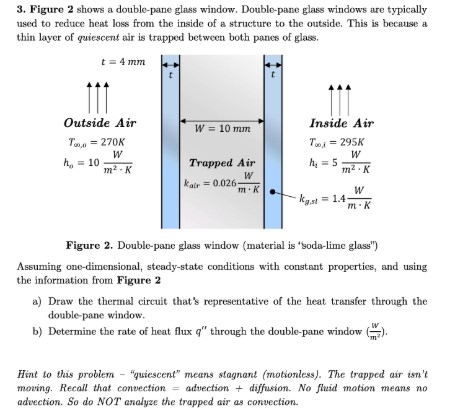QQuestionAnatomy and Physiology
QuestionAnatomy and Physiology
3. Figure 2 shows a double-pane glass window. Double-pane glass windows are typically used to reduce heat loss from the inside of a structure to the outside. This is because a thin layer of *quiescent* air is trapped between both panes of glass.
**Figure 2.** Double-pane glass window (material is "boda-lime glass")
Assuming one-dimensional, steady-state conditions with constant properties, and using the information from **Figure 2 **
- a) Draw the thermal circuit that's representative of the heat transfer through the double-pane window.
- b) Determine the rate of heat flux *q'*<sup>H</sup> through the double-pane window (α<sup>H</sup> = 1).
*Hint to this problem – "quiescent" means stagnant (motionless). The trapped air isn't moving. Recall that convection = advection + diffusion. No fluid motion means no advection. So do NOT analyze the trapped air as convection.*
Attachments

6 months agoReport content
Answer
Full Solution Locked
Sign in to view the complete step-by-step solution and unlock all study resources.
Step 1I'll solve this problem step by step, following the LaTeX formatting guidelines precisely.
Step 2: Analyze the Double-Pane Window Components
- Temperature difference: $$\Delta T = 40 \mathrm{~K}
The window consists of: - Outer glass pane (boda-lime glass) - Air gap (quiescent/stagnant) - Inner glass pane (boda-lime glass) Given information:
Final Answer
The rate of heat flux q'^{H} through the double-pane window is 85.11 \mathrm{~W/m^{2}}. Key Insights: - The air gap provides significant thermal resistance - Quiescent air has low thermal conductivity - Thermal resistance is calculated by thickness divided by thermal conductivity
Need Help with Homework?
Stuck on a difficult problem? We've got you covered:
- Post your question or upload an image
- Get instant step-by-step solutions
- Learn from our AI and community of students